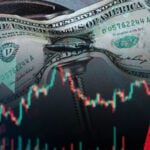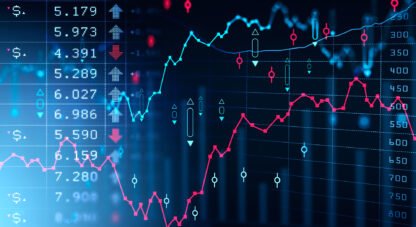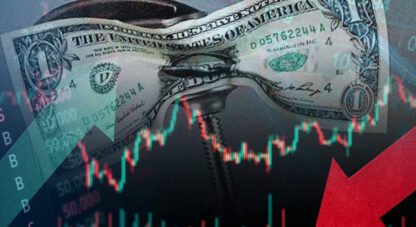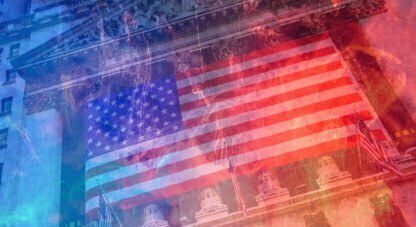Podcast: Play in new window
Bank Bailout Spurs Bubble Revival
Disclaimer: Advisory services are offered by McAlvany Wealth Management, an investment adviser registered with the U.S. Securities and Exchange Commission. The comments made in this audio recording discuss economic and market trends and are not intended as advice for any particular investor. A short selling strategy involves a substantial degree of risk. Any decision to engage in a short selling strategy should be reviewed with your financial adviser. Past performance is no guarantee of future results.
MWM Q2 2023 Tactical Short Conference Call
August 3, 2023
David McAlvany: Good afternoon. This is David McAlvany. Thank you for joining us. I can’t believe that it’s already August, that 2023 is flying by. And we get to punctuate the year with these quarterly calls. It’s the closest thing we have to being students again, where our time was punctuated with the passing of semesters. So Doug’s got a lot in store for us today talking about bank bailouts and how that has spurred bubble revival.
Just want to say good afternoon. We appreciate your participation in our second quarter 2023 recap conference call. And as always, we want to thank our valued account holders. We greatly appreciate you. We greatly appreciate the opportunity to serve you in a client relationship. And just as a part of that, the team that is here to answer your questions and to help with anything that we possibly can, Ted, Robert, Philip, Morgan, myself, if there’s anything at all that we can do to enhance that relationship, do let us know. And Doug, of course, thank you for your leadership with Tactical Short.
For first time listeners on today’s call, we’ll begin with some general information, and for those that are unfamiliar with Tactical Short. And if you’re interested, more detailed information can be found at mcalvany.com/tacticalshort. We’ve redone our website, what once was mwealthm.com. You can still get there, you can still go there. But at mcalvany.com, it sort of introduces you to the universe of things that we offer. In that place, you’ll find some of our informational resources, which for those of you who are not familiar with Doug’s routine contribution, daily contribution, Credit Bubble Daily and his Credit Bubble Weekly are must engagements. The Daily is his curation of news and events, which will save you hours of reading and research. And I would encourage you to, again, go to mcalvany.com and go into the informational resources segment.
Doug curates that on a daily basis, and then weekly is his Credit Bubble Bulletin, which some of you have been reading for decades. He’s been chronicling the events in the credit markets for a long, long time and provides insights, deep insights, connecting critical dots on a weekly basis. So, again, more detailed information on the product itself, Tactical Short, you’ll find there, but those resources will be invaluable to you as well.
Why do we do what we do? Well, the objective of Tactical Short is to provide a professionally managed product that reduces the overall risk in a client’s total investment portfolio, while at the same time providing downside protection in a global market backdrop with extraordinary uncertainty and extreme risk. That’s the objective. This strategy is designed for separately managed accounts. In that format, it is investor friendly with full transparency, the ultimate in flexibility, reasonable fees, and no lockups.
We have the flexibility to short stocks as well as ETFs. We also plan on occasion to buy liquid listed put options. And Doug will explain a little bit of that. There’s always a dance between when and how to engage with that particular methodology and strategy. So shorting entails a unique set of risks, and we are set apart from our competitors by our analytical framework as well as our uncompromising focus on identifying and managing risk.
I will go through some of these numbers if you’re taking notes. There’s a few things that I want to point out here. Our Tactical Short strategy began the quarter with short exposure targeted at 79%, so that gives us an exposure, roughly 79% of the inverse of the S&P. And the target was held steadily throughout the quarter. We focused on the extremely challenging backdrop for managing short exposure, and used the S&P 500 ETF, SPY. That was the default position for the portfolio with an incredibly high risk environment unfolding.
This year’s first half market environment further validates why we do not encourage aggressive bets against the stock market. As we stress during each call, remaining a hundred percent short all of the time—and that’s what most short products do, that’s how they’re structured—that, in our view, is risk indifference. And so aggressive shorting can at times be very rewarding, choosing individual names. But the market over recent years, and again so far this year, inflicted very painful losses on the short side for those who are indifferent to risk.
We believe a disciplined risk management is absolutely essential for long-term success. We structured Tactical Short to ensure the flexibility to navigate through even the most challenging market conditions, and I think that’s what this quarter proved yet again.
For performance, I’ll give you some numbers and then a quick comment on it. To update performance for the second quarter, Tactical Short accounts after fees returned a negative 6.1% during Q2. Compare that to the S&P 500, which was up 8.74%.
The target, as I mentioned earlier, target exposure was 79%. But for the quarter, Tactical Short accounts lost 69.8% of the S&P’s positive return. And I just want to highlight that in particular because this is where Doug’s science meets Doug’s art. There is a timeframe in which to rebalance the portfolio, and when and how to get that done can create some performance differences, in this case, a benefit to our clients. Targeted short exposure, 79%, we did not lose 79% of the inverse of the S&P. 69.8 again is where we were at for the quarter. As for one-year performance, Tactical Short after fees returned a negative 12.74% versus the 19.56% return for the S&P 500. And again, those numbers are interesting as well. Tactical Short lost 65.1% of the S&P’s positive return.
We regularly track Tactical Short performance versus three actively managed short fund competitors, and that I think was also interesting. First, the Grizzly Short Fund, which returned a negative 6%, 6.37% during Q2. Over the past year, Grizzly’s returned a negative 20%. Ranger, a negative 11.09% for the quarter. It’s Ranger Equity Bear Fund. Again, 11.09 for the quarter, negative 29.49 for the one-year return. Again, just keeping in mind that that’s greater than the positive returns of the S&P by a wide margin. Federated Prudent Bear returned a negative 8.1% during Q2 and a negative one-year return of 16.53%. Tactical Short outperformed all three actively managed short funds during the quarter with average outperformance of 242 basis points. And Tactical Short also outperformed the three funds over the past year by an average of 934 basis points.
Tactical Short has significantly outperformed each of the bear funds since inception. Again, I think this comes back to the risk management focus, and also the rebalancing, which is— To see Doug’s engagement with the details within the marketplace, and then determine when to do that, is, again, what I would describe as the meeting of art and science.
From the April 7th, 2017 inception through the end of March, Tactical Short returned a negative 41.72% versus the 110.79% return for the S&P 500. On average, we’re outperforming our three competitors in that same timeframe by 2,600 basis points, 26 percentage points. There’re also popular passive short index products versus the active ones we just mentioned. The ProShares Short S&P 500 ETF returned a negative 6.32% for the quarter, negative 13.9% for the past year. Rydex Inverse S&P 500 Fund, a negative 6.35 for Q2 and a negative 13.85 over one year. PIMCO also runs the StocksPLUS Short Fund, and Q2 was down by 5.87, one-year negative returns of 13%.
And that is summary of performance. We’ll come back around as soon as Doug concludes his comments with Q&A. And Doug and I will both engage with you on that. Thanks for submitting those questions in advance.
Doug Noland: Thank you for your kind words, David. And hello, everyone. Thank you for being with us today. Yes, it was one more in a string of extraordinary quarters. To get us going I’ll start with a focus on something David just said, something he has repeated for a number of calls. I’ll quote here, “Focused on the extremely challenging backdrop for managing short exposure, a short in the S&P 500 ETF remained the default position for high risk environments.” Well, when David and I were initially discussing the creation of the Tactical Short strategy, it was absolutely imperative that we had the necessary flexibility to prudently manage short exposure. Throughout my career as a manager of short exposure, I’ve sometimes faced intense pressure to boost exposure to individual company’s short positions.
And this pressure, it often came when I knew that shorting company stocks was a high-risk proposition when my analysis clearly pointed to an unfavorable risk versus potential reward calculus. David and I, back in 2017, we never imagined that we’d be here in 2023 with the market having doubled. The Fed’s balance sheet back then was 4.4 trillion, having more than doubled from when the Fed in 2011 publicized their exit strategy that included major asset reduction. David and I knew the Fed and markets faced a major challenge as our central bank moved toward normalizing monetary policy. And we saw in 2018, and again in 2019, confirmation of our thesis of underlying financial, economic, and market fragility.
Financial fragility, the highly levered repo market in particular, became a serious issue in the summer of 2019, spurring the Fed to restart QE, and that was despite an expanding economy and booming markets. And not many months later, the world was hit by the worst pandemic in a century. To thwart bubble collapse, the Fed resorted to 5 trillion of additional QE liquidity, with the Fed’s balance sheet surpassing 9 trillion—an astounding 30-fold increase from when I began my career in investment management back in 1990.
Markets that had evolved to become highly speculative in the easy money post-great financial crisis landscape, they turned manic and dysfunctional. Tens of millions were trading online with millions lured to the options market. Meme stocks, it became a thing. And the sport of squeezing shorts turned highly lucrative, and that’s for hedge fund managers as well as online traders. They’re all glued to their social media accounts in search of the next prime squeeze target.
And this dysfunction was nourished by trillions of pandemic stimulus. And it became about the most un-level market playing field imaginable for shorting individual company stocks. The two actively managed short funds most focused on individual company shorting suffered quarterly losses in excess of 20%, losing during those periods about double the S&P 500’s return. One of those funds lost 32.5% during Q4 2020. This same fund is down 27% so far this year.
I never imagined that we’d be into year 2023 and still positioned with our default S&P 500 short exposure. I’m nothing if not disciplined. Our analytical framework has continued to signal a high-risk backdrop for shorting, so we’ve adhered to our analysis and our risk management disciplines. The bottom line is it’s been a good time to not be short individual company stocks.
When we designed the strategy, we expected the occasional tactical and prudent purchase of listed put options, and it’s a similar story here. The backdrop has beckoned for caution. And I’m happy we’ve kept our powder dry in options trading.
And I’ll also say that one of the problems common to shorting individual stocks and trading options is that once you’ve suffered losses, it becomes really tough to just walk away. Psychologically, you are compelled to recover losses with the next short or the next option idea. And one of my cardinal risk management mantras is: poor performance begets poor performance. Losses too often induce risk taking and only more losses. You get behind the performance eight ball and face intense pressure to recover steep losses—pressures that too often breed suboptimal decisionmaking.
Our S&P 500 default short positioning is critical to our risk management-focused investment process. We’ve been able to avoid accidents and outsized losses. Admittedly, it’s been a brutally tough period, but we’ve outperformed our competitors and performed about as advertised. We continue to strive to fulfill our mandate of providing a reliable market hedge within carefully defined and communicated risk parameters.
Let’s now segue to our analytical framework in the ongoing extraordinary environment. I’ll start this segment by restating analysis I’ve underscored over the years. Unique in history, global finance over recent decades has operated without constraints on either the quantity or the quality of new credit instruments. There’s been no gold standard or even an ad hoc dollar reserve system that would help hold credit creation in check. And importantly, credit expansion has operated unconstrained from traditional bank reserve and capital requirements.
I came to this understanding and formed this thesis back in the late ’90s after witnessing the unbridled expansion of non-bank credit—and that’s the repo market, Wall Street Finance, the GSEs, mortgage asset-backed securities, money market funds, and massive unregulated derivatives markets. The world of finance had fundamentally changed. Credit had become more readily available, especially for risky borrowers, and the price of credit and finance more generally had cheapened. And as leveraged speculation mushroomed, speculative leverage evolved into a prevailing source of system liquidity creation. The unfettered expansion of leverage enlarged the pool of marketplace liquidity, creating a dangerous proclivity for self-reinforcing speculation, credit, and liquidity excesses. In short, financial innovation and structural developments fueled a secular loosening of financial conditions. A most crucial issue as we analyze current market policy and economic backdrops.
I’ve discussed this previously. Silly me, I guess. I fully expected central bankers would eventually recognize the dangers and rein in this new financial structure. As it turned out, it was more that market-based finance took control and placed reins on central banking. It used to be that the so-called bond vigilantes and the prospect of surging market yields would discipline policymakers, and have central bankers erring on the side of tighter money and governments working to control budget deficit spending. These days, the threat of collapsing market bubbles ensures perpetual loose conditions and runaway government debt.
Let’s focus on the Fed’s current tightening cycle. It’s extraordinary. The Fed has moved aggressively to hike interest rates 525 basis points in 16 months, yet financial conditions are arguably looser today than when the Fed commenced the process. And they would never admit as much, but the Fed must be shocked and bewildered. It certainly throws a monkey wrench into contemporary central bank doctrine.
Financial conditions indicators that I closely monitor, including investment grade and high-yield corporate spreads and CVS prices, traded last week at the lowest since the start of Fed tightening. And while there’s been some tightening of bank lending—from an egregious level I might add, this has been offset by strong bond issuance and booming private credit and so-called decentralized finance.
I believe we’re today at a crossroads. I expected this to be the first actual tightening cycle since 1994. Fed rate hiking cycles since ’94—and that includes the late-’90s tech bubble period and then again during the mortgage finance bubble—they failed to sufficiently tighten financial conditions. But the impetus behind the current tightening has been more urgent for policymakers. Consumer and producer inflation was spiraling out of control. Despite core year-over-year CPI inflation still above 5%, the Fed is widely believed to be either done or close to wrapping up this tightening cycle. Most importantly, ongoing loose financial conditions pose huge risks to the Fed and the system more generally.
I’ll break these risks into two broad categories. First, we expect inflation to prove much more persistent than either the Federal Reserve or the markets anticipate. Second, loose conditions are fueling dangerous asset inflation and speculative bubbles.
Let’s explore inflation risk. We believe the secular of relative consumer price disinflation has largely run its course. Moreover, our view is that the previous cycle was aberrational, whereby consumer and producer price inflation remained generally contained even in the face of momentous monetary inflation. Certainly, globalization and the rise of low-cost Chinese and Asian manufacturing played integral roles. But there was also the secular dynamic of powerful financial flows primarily fueling asset inflation as opposed to traditional consumer price inflation. Especially with central banks backstopping financial markets, financial assets developed a dominant competitive advantage versus real economic investment. And the greater the flows into inflating financial markets and the more certainty of central bank backstops, the more powerful the asset inflation and bubbles.
But the massive pandemic response coming late in an already extended cycle, it changed the game. You could say that unprecedented monetary inflation and fiscal deficits broke the dam, unleashing inflationary forces into the real economy while stoking a historic mania throughout the markets. Acute supply chain issues forced businesses to rethink how they needed to manage inventories and resource procurement, while an acute shortage of workers triggered a major change in compensation expectations. And then Russia’s invasion of Ukraine, with China’s unflinching partners-without-limits amoral support, provided a major push to new cycle deglobalization.
We believe the world is transitioning to a new cycle where hard assets outperform financial assets, where commodity and consumer price inflation holds sway over asset inflation. I know it sure hasn’t looked that way over recent months, with speculative zeal overcoming the securities markets, but we expect this phenomenon to prove fleeting. While loose financial conditions have supported the markets, we believe such easy money at this phase of the cycle comes with significant risks and negative consequences.
Before jumping into the risks, let’s briefly delve into how we got to this point. In the first place, years of artificially low rates and repeated market bailouts ensure deep market maladjustment. Why haven’t financial conditions tightened as expected, as they have historically? Because the bond market has been conditioned to anticipate the next round of monetary loosening. And the crazier the market excesses, the more the Treasury market prices in probabilities for some type of accident, forcing the Fed to again slash rates and employ more QE securities purchases.
It’s worth recalling that 10-year Treasury yields surged last fall to the highs back to 2008—at least partially triggered by the UK’s bond deleveraging and market crisis. Markets were comforted that the BoE hastily resorted to additional QE before it had even opportunity to normalize rate policy or begin QT. Understandably, markets feared that the central bank market liquidity backstop had been placed on the back burner as inflation worries and monetary tightening took precedence. And after being partially allayed by the Bank of England, the Fed’s response to the March banking crisis completely resolved market concerns.
And we need to take a few minutes to discuss the banking crisis—and I’m sticking with the word crisis. After all, we saw a systemic bank run and three of the four largest banks fail here in US history. Moreover, there was a rapid and powerful crisis response from Washington. In just three weeks, Federal Reserve credit expanded 391 billion. But the liquidity backstop went far beyond the Fed. The government sponsored enterprises—the GSEs—they expanded assets by a record 352 billion during Q1 to an all time high, 9.54 trillion, surpassing even the 325 billion response to the Q1 2020 pandemic crisis. It’s also worth noting that GSE assets inflated a record 1.02 trillion over the previous four quarters. Fully double peak one-year growth from pandemic 2020.
There were remarkable developments throughout the financial sector. Wall Street broker-dealer assets jumped 452 billion in Q1, or 41% annualized, while fed funds and security repurchase agreements—and this is data from the Fed Z1 report—that category surged an incredible 815 billion, or 46% annualized. And indicative of massive monetary inflation, money market fund assets expanded 470 billion during Q1 to a record 5.7 trillion.
The banking crisis prompted one more in what has been a series of momentous liquidity crisis responses, but that just got things going. The intervention triggered a short squeeze and unwind of hedges, both providing meaningful sources of additional liquidity. Surging markets then unleashed FOMO, fear of missing out, huge flows into the markets. And importantly, the derivatives market played an additional major role. Aggressive buying of call options, energized bubble dynamics, as a rapidly rising market forced those that had sold call options to hedge their positions through levered purchases of stocks and ETFs. Stir up this degree of liquidity and speculative excess in an already energized marketplace, and you’re asking for trouble.
And there was this fledgling bubble quietly waiting for its moment: artificial intelligence. And AI was bubble perfect. Talk about an investment thesis open to the wildest of imaginations. Nebulous, and the sky’s the limit. Perfect for the so-called Magnificent Seven dominating the major indices, and perfect as well for companies everywhere that can now name-drop AI in a press release, presentation, or quarterly earnings call, and watch their stocks shoot higher.
Nvidia today enjoys a year-to-date gain of 207% and a $1.1 trillion market cap. Meta Platforms has made a stunning recovery with 162% 2023 gain. Both had big short positions going into the banking crisis.
And let me explain how this works. There’s an ideal formula for cooking up a spectacular short squeeze. It’s when you have significant fundamental deterioration, and then some alluring bullish story seemingly comes out of nowhere. It’s thrown into the mix. This is precisely this year’s circumstance in the technology space.
Tech was under pressure in 2022. Tightened financial conditions were bursting bubbles, and this was leading to scores of layoffs and business failures as finance abruptly tightened for venture capital and startup finance. Scores of negative cash flow companies were losing their lifelines. But then the flood of liquidity, the resulting dramatic market recovery, and the AI mania rapidly loosened finance throughout the sector. It was the perfect storm for a major short squeeze. The Goldman Sachs short index has gained 37% year-to-date, bolstered by a 17-session, 24% surge starting on June 26th.
Especially at this stage of the cycle, you cannot overstate the importance of financial conditions. For individual companies, it can be the difference between prospering and failure. For certain industries, it’s the difference between ongoing boom or bust. And with this massive short squeeze, FOMO, and derivatives melt up, the tech space this year does recall a similar dynamic that marked a 15-year top for NASDAQ in Q1 2000.
Importantly, this year’s bubble revival dynamic has not been limited to the technology sector. I’ll use the example of online car reseller Carvana. This stock dropped 98% last year as the company fought for survival after losing access to borrowings, and that includes securitizing its auto receivables. Last year’s tighter financial conditions had stirred fears of recession and credit problems which manifest initially at credit’s risky periphery.
Well, financial conditions have this year loosened, demand for securitizations has recovered, and Carvana’s stock has surged over 800%. Carvana is a microcosm of risky lending and the significant impact fringe finance has throughout our economy. Last year, tighter financial conditions had begun to pierce that bubble, but this year’s loosening has granted risky lending and extended lease on life in consumer, mortgage, and corporate finance. It has made the difference between economic recession and expansion. And I would strongly argue that this year’s loosening has only extended what I refer to as terminal phase excess, another year of inflating bubbles that ensure only deeper and more protracted market and economic adjustment ahead.
It has been integral to my analytical thesis that years of loose finance resulted in severe structural maladjustment to the US economy—major resource misallocation and malinvestment, and the proliferation of scores of uneconomic negative cash generated enterprises. This maladjustment makes the US economy especially vulnerable to tightened conditions—tightened money and credit. But as we’ve witnessed this year, a loosening of financial conditions can extend the life of this bubble economy structure. Most economists and analysts view this year’s resilience as confirmation of sound underpinnings.
I do not believe today’s loose conditions are sustainable. Indeed, I see all the confirmation of the bubble thesis imaginable. But with markets booming, analysis has turned decidedly bullish. Soft landing, Goldilocks, and immaculate disinflation, they fill the headlines. The latest is Ed Yardeni’s nirvana scenario, where the bond market is supposedly signaling all gain and little pain. The end of nasty inflation without a spike in unemployment or a hit to stock prices.
In Friday’s CBB, I used a quote from Paul Newman. “If you’re playing a poker game and you look around the table and can’t tell who the sucker is, it’s you.” With the Fed today content with loose financial conditions and the risk-on market bubble bolstering confidence and economic activity, the bond market is not feeling the nirvana. It’s instead nervously looking around the poker table. We need to be clear on something. This is one historic global financial scheme. The system just keeps generating trillions of new credit and financial claims while central banks print money and manipulate markets to artificially inflate market values of hundreds of trillions of financial instruments.
This has inflated a historic gap between the market value of financial claims versus real economic wealth, and this gap has widened significantly more this year. Over the years, I’ve quipped that bubbles have a propensity for inflating to unimaginable extremes, and then to double. After the pandemic crisis response, I replaced double with quadruple.
If we’re right on new cycle inflation dynamics, bond markets are vulnerable here. Bonds are the sucker, and they could end up ending this party in a hurry. 10-year yield spiked to 8% during the last tightening cycle back in 1994. Yields are half of that today despite inflation higher than in ’94.
Over this period, a new paradigm unfolded. With bond market focus shifting away from traditional fundamentals instead to prospects for Fed rate cuts and crisis response QE. After the restart of QE in 2019, 5 trillion of COVID QE and the recent bank crisis response, it’s understandable that bond pricing reflects the near certainty of ongoing aggressive monetary stimulus. But with financial conditions remaining so loose and the Fed winding down rate increases, I see the makings for a paradigm shift.
Bond focus could pivot to the risk of a sticky inflation backdrop and more prolonged Fed tightening cycle. I see Tuesday’s Fitch US debt downgrade as a shot across the bow. Fundamentals do matter. And despite all the Wall Street and Washington pushback against Fitch’s decision, Treasury debt has inflated from 6 trillion to 27 trillion since the end of 2007, growing from about 40% of GDP to over 100%. Meanwhile, inflation risks seem to be regaining focus. Crude rallied back above 80, with surging gasoline futures prices up 20% year to date. Russia canceled the Black Sea grain deal, and then proceeded to bomb Ukraine’s export infrastructure. A brutally hot summer is fueling global food insecurity, with India recently limiting rice exports. The heat is also impacting refinery output and spurring higher prices at the pump. And with an increasingly desperate Beijing adopting more aggressive stimulus, there’s been a bounce in copper and industrial metals prices.
In total, it appears the makings of the type of strong recovery in commodities prices that would rekindle inflation fears and bond market angst. What’s more, we’re entering a period of major global policy uncertainty. Central banks moving predictably and in unison create a backdrop of relative predictability for the global leverage speculating community. But uncertainty now clouds the picture. Europe’s economy is weakening with further ECB tightening now in doubt. Here at home, loose conditions raise the odds of the Fed extending tightening. Meanwhile, pressure is mounting on the Bank of Japan to commence normalization after years of reckless negative rates and yield curve control. Between Japanese savers and institutions fleeing zero yields and global speculators borrowing freely in yen, the amount of Japanese finance that has been fueling global bubbles is literally in the trillions. This powder keg will overhang markets over the coming months.
David: Doug, in some respects, when you think of the liquidity that’s been flowing, it’s been sort of a classic setup for malinvestment.
Doug: No doubt about it. Flowing for way too long, of course, David.
Yeah, in today’s loose financial conditions, they sow the seeds for a major global financial crisis. And there are various possible scenarios. I’ll focus on one in particular that is anything but a long shot: Loose conditions underpinned market speculation, economic demand, labor tightness and inflationary pressures, bond yield surprise to the upside, pressuring the Fed to tighten conditions and intensify its inflation fight, higher rates and yields unnerve a complacent stock market with particular risk for the now over-owned and over-leveraged Magnificent Seven and the other high-flying growth stocks.
An abrupt market reversal would simultaneously trigger several liquidity-destroying dynamics. Portfolio managers that allowed their risk hedges to expire over recent months move aggressively to reestablish market protection. Hedge funds that cut back their shorts while pressing their longs try to quickly rebalance their portfolios. Derivative dealers that have been aggressively buying stocks and ETFs on leverage to hedge in-the-money call options suddenly reverse course and become forceful sellers. And the public, having loaded up on growth stocks and ETFs after believing the all’s clear had been sounded, receives a shocking reminder of market risk.
It is the nature of contemporary market bubbles that the bullish perception of endless liquidity can quickly confront the realities of de-risking/de-leveraging, illiquidity, dislocation, and panic. This was experienced in the UK last September and in the US banking system this past March. And recall the key issue from March, when suddenly bankers, regulators, and Fed officials were awakened to today’s reality that destabilizing bank runs are only online chat boards and mouse clicks away. Virtually overnight, uninsured bank deposits posed a major systemic risk. So, what about latent systemic risks associated with ETF and money market funds—shares the public views as money-like, liquid, and safe stores of value?
I would really prefer not to sound this way, but from my analytical perspective, this has been an ongoing trip along the worst-case scenario. History informs us that the most problematic crises erupt in money-like markets—bank deposits in March, the repo market in 2008, and with ETFs in 2020. Panic can quickly take hold when there’s a sudden fear of loss in instruments that had been perceived as safe and highly liquid.
It’s worth noting that household deposits have inflated 3.8 trillion, or 36%, since the start of the pandemic. And money fund assets have surged 1.85 trillion, or 51%. And I certainly appreciate the view that the Fed won’t allow a bank or money market crisis, and they’ll buy ETF shares if they need to. And since fragility lies just below the surface, they’ll respond quickly before crisis dynamics gain momentum, as they did in March. But such an approach risks excessively loose conditions and spiraling inflation. I doubt it would be long before the bond market protests, and it’s the bond market that could call the shots going forward.
A surge in bond yields would certainly get the Fed’s attention. I recall how the 1994 yield spike caused confusion at the Fed. Were they raising rates too fast and scaring the bond market, or were yields surging because the Fed was behind the curve?
The Fed is feeling pretty good about things right now—inflation, the economy, and markets. I call it bubble mirage. We’re only a jump in market yields away from a quite challenging backdrop for the markets and policymaking.
And speaking of challenging backdrops, I have just brief comments on China and the geopolitical environment. Not surprisingly, China’s post-COVID recovery was short and unimpressive. Ramifications for the bursting Chinese apartment bubble have begun to sink in. The Chinese developer bond collapse, it has accelerated, with bonds of industry heavyweights Evergrande, Country Garden, Longfor, Sunac and others now trading for pennies on the dollar.
Importantly—and there’s hundreds of billions of dollars of debt involved here—importantly, it appears that Chinese people have lost confidence in housing as the primary source of wealth accumulation. As price declines accelerate, we could see an outright crisis of confidence. Today, tens of millions of apartment units bought for price speculation, they just sit there unoccupied. When owners begin sending keys to lenders, and these empty units hit the market, bubble deflation will take a decided turn for the worse.
As I addressed in the Q1 call, I fear China’s bursting bubble poses major geopolitical risks. It’s already clear that Beijing will chiefly blame the U.S. for its woes, deflecting responsibility for what’s been gross mismanagement of its financial and economic systems. This partners-without-limits relationship with Putin’s Russia turns more ominous as the Ukraine war extends and intensifies.
I highlighted in Friday’s CBB a Reuters article reporting how Chinese and Russian officials stood shoulder to shoulder with Kim Jong Un at a military parade showcasing North Korea’s newest nuclear capable missiles. This article noted that these armaments are banned by the UN, and in previous years Beijing and Moscow sought to distance themselves from such displays. And just this past weekend, former Russian President and close Putin ally Dmitri Medvedev again warned of the risk of nuclear confrontation.
Let’s assume such a catastrophe can be avoided, but we’re still left with Beijing’s sights fixated on Taiwan, siding with the likes of Putin, Kim Jong Un, and Iranian leadership. Everything seems to point to a continued fracturing of the existing world order, with negative ramifications for trade and financial flows, inflation growth, security, and overall stability. Further confrontation appears inevitable, and we can only pray it remains mainly financial and economic.
At the minimum, we expect the unfolding secular shift to a bipolar world to be an important factor underpinning higher inflation. Besides trade friction, supply chain disruptions, and a major push towards self-sufficiency for key resources and manufacturing capabilities, the unfolding battle for global supremacy will promote inflationary policymaking. A bursting bubble certainly stands in the way of China’s objective of global superpower status and anchor to a new anti-American global alliance. Expect China to adopt whatever massive fiscal stimulus, bank lending, and money printing they deem necessary to prolong the illusion or predominant economic and financial power.
To wrap this up, I want to stress that it’s no coincidence that we are witnessing manic markets in the face of mounting economic and geopolitical instability. They share the same root cause of an extended period of monetary disorder. History informs us that things tend to run wild near the end of long cycles. I chalk this up to decades of monetary inflation, increasingly reckless policymaking and resulting excessive risk taking and emboldened speculators, along with deepening structural maladjustment. Consequences include intractable bubbles, myriad fragilities, and policymakers desperate to hold collapse at bay. Bubbles are so incredibly seductive, and end up fooling just about everyone. And bubbles are at their core mechanisms of wealth redistribution and destruction. Insecurities, animosities, and conflict are inevitable domestically and globally. We bear witness to all of this today.
For too long, policymakers have resorted to only more egregious monetary inflation and non-productive debt growth. This deeply flawed doctrine has only made the unavoidable day of reckoning all the more frightening. It’s a grim picture I paint, I know, but I can say with my heart and soul that our analytical framework and vigor coupled with our investment process and discipline will be of great value to Tactical Short and MAPS investors as we navigate through challenging times. Thank you so much for your time today. David, back to you.
David: Thank you, Doug. I want to encourage all of you to, again, go to mcalvany.com, and you can look at further information on the Tactical Short offering. With questions, please send them to [email protected], and if you have an immediate interest in beginning the process of setting up a separately managed account for Tactical Short to help hedge and protect your overall wealth picture, please don’t hesitate to send a note of interest to [email protected].
We’ll begin with the Q&A, and Doug, the first question, I think, is a good one for you. “What is your assessment of a melt-up in stocks beyond the AI darlings and what is the best segment of the U.S. stock market to short? U.S. Commercial real estate? Crypto ETFs? Are Chinese stocks or bonds a target for shorting? Indian stocks?” Over to you.
Doug: From my perspective, we’ve been in a market melt-up dynamic, and it was led by the big tech and short stocks, but then broadened into the small caps and just a general market melt-up. The past couple of sessions, these surging bond yields, they’ve put a bit of a damper on things. Stocks are pulled back, and we’ll have to watch to see if this is a pause that refreshes for the melt-up or the start of something important. It’s worth noting that as we speak, 10-year yields and benchmark MBS yields, they’re nearing highs from last October. I think these are these very important highs. If yields break decisively higher, I think this would signify another leg to the bond bear market, and this would be one that would really catch people by surprise.
Stock market melt-ups, they’re inherently vulnerable to abrupt reversals. Everyone gets caught on the wrong side of the boat, and I just concluded in my discussion there potential mechanisms that could radically alter the market liquidity backdrop. This is high risk for the market. I know better than to predict the market or try to call a market top, but it wouldn’t be all that surprising to me if July highs in NASDAQ turned out to be a top for a while, and maybe a long while.
I’m afraid— I’ll apologize here. I’m not going to be very helpful with short ideas. I actually try to dissuade individual investors from shorting. I know some are experienced at this, so, fine, for those, go for it. Most are not experienced. Most don’t appreciate the risks of shorting and how you can really get hit quickly with significant losses.
Especially in the current highly unstable environment, I would avoid commonly shorted stocks and sectors. A lot of the obvious shorts, those are the ones that have the biggest squeezes. They just become very high-risk shorts. For me, in an unstable environment, I want to avoid higher volatility stocks, generally, to short. That’s why we have our default short exposure where it’s a really carefully defined beta or how much that short exposure moves when the market moves.
I know professionals are out shorting commercial real estate and crypto and the Chinese ADRs, and they’ve all been quite the battleground for shorts versus the short squeezers. I’m more than content to avoid all of that. As far as Indian stocks, I have to admit I’m uninformed, so I have no insight there to offer.
Thank you for your questions. Sorry, my answer is probably not very satisfying.
David: The next question, “What do you make of China’s accumulation of gold bullion from a geopolitical perspective?” I’ll take a stab at this.
The accumulation’s been impressive, not only by China but also other central banks. I think, like other central banks globally, the accumulation of gold bullion expresses a shift in preference for the reserves, denomination of their reserves. It expresses a priority for greater direct control of those reserves. Doug’s final comments there on geopolitics, there is a shift from a unipolar to a multipolar world, and with it comes new assumptions, new tactics. As we enter a post-, if you want to even call it a post-peace era, the framework of increasing cooperation which we’d previously had, and improved trade relations, will be challenged more and more. As that unfolds, you’ve got greater degrees and varied kinds of insecurity which drive increased central bank purchases.
This last year, obviously one of those expressions of insecurity is, if you are sitting on our money, can we have it when we need it? In this case, the Russians and the loss of quite a bit of money that the U.S. Treasury had access to. Again, this priority of direct control of those reserves becomes underscored. China’s gold accumulation is a means of insulating from dollar exposure, and it’s also a means of shielding from Treasury Department measures which would be understood as controlling or as disadvantageous to the Chinese Communist Party. Long-term, it also serves as a means of validating their currency. If you look at the longer-term trajectory for the yuan or the RMB, what suggests validity? What suggests that you can have confidence in this currency? Trust is vital in any monetary scheme. I think gold provides a measurable reason to trust. This comes back to, certainly, China’s accumulation of gold bullion has a whiff of the geopolitical to it. This is not just a financial or economic decision.
The next question, “I’ve been reading the credit bubble bulletin for over two decades. My first issue was the classic coin in the fuse box. Also, just finished reading The Fourth Turning by Neil Howe. I’d like your thoughts on this. Seems like the bursting of the everything bubble will take much longer to play out than thought, and won’t begin to in a big way until the Dow-to-gold ratio begins a significant move towards 3:1, the gold/silver ratio towards 30:1. Been putting funds into my vaulted account on a regular basis.” Your thoughts, Doug?
Doug: Yeah. First of all, thank you very much for being a long-time reader. This is, I guess, the 25th year of my labor of love, and it’s readers like you that keep me motivated late into my Friday night. So thank you. Thank you for sticking with me. I feel like we’re family now.
For those not familiar, coin in the fuse box was how Alan Greenspan explained in the 1960s that the root cause of the ’29 crash and Great Depression. There’s a good book to be written on that hopefully sometime in the future. I think about this often, and how applicable it is to their current environment. There are just these uncomfortable parallels in how this plays out. I’m sure David has thoughts on this as well, the so-called Everything Bubble. It’s history’s greatest bubble, and it’s inflated so much bigger and longer than I ever imagined. I never thought the Fed would just print a quick 5 trillion. I’m surprised confidence has been sustained in China’s banking system as it has inflated to about 60 trillion. I’m surprised Treasury yields remained so low in the face of unprecedented issuance.
As I explained earlier, it’s been the central banks and ongoing loose money that have made these unprecedented developments all possible. Could this bubble keep inflating? Yeah, sure. I mean, sure. Central bankers are tightening now after being shocked by a surge of inflation. This is different. This is different. As I discussed, inflation could prove sticky. The Fed could be forced to tighten more than expected. And there’s also the Bank of Japan that is either going to have to begin normalization or face a collapsing currency.
From my analytical perspective, the great bubble, it’s in high-risk territory these days. Plus you’ve had an equities market melt-up that raises the odds of a destabilizing reversal. Overall, I see the risk of de-risking/deleveraging as high—very high—and rising. I’m not predicting the Great Bubble’s imminent demise, but I’m certainly monitoring developments very closely. There is a much greater degree of fragility than market participants, policymakers, and the general public today appreciate. Again, thanks for reading. Thanks for your question.
David: Yeah, just to add to that, I mean, the fragility you speak of, Doug, I think the Dow:gold ratio does point to things in the financial markets being weaker than you think, weaker than they appear. We get caught up in nominal values. That we put in new all time highs in 2021, that’s impressive in one sense, but if you measure it in relative terms to gold you have a very different story.
Just to give you some perspective, and maybe to flesh out a little bit that question, the Dow:gold ratio is this ratio that shows you a preference for financial assets versus tangibles like gold. It’s also an expression of greed and fear, and which of those aspects is most dominant in the marketplace. If you go back to 1929, obviously, the stock market is raging. It’s very impressive. I mean obviously before the collapse, but up to that point there was a lot of positivity and everybody wanted to own stocks. Nobody really cared about gold. The ratio between the two was 18:1.
You move into a different era after the Great Depression, once gold’s taken out of the monetary system and credit and money become unhinged, and the next major peak in the Dow:gold ratio exceeds that by almost 50%. We get to a 28:1 ratio in the ’60s. Okay, this is, again, a timeframe, let’s call the stock market peak coming out. I guess we started the bull market, let’s call it 1949, and it extends through the late ’60s, call it ’67, ’68. Dow:gold ratio is at 28:1. People don’t care about gold. You can exchange your stock portfolio for a ton of gold. Again, it’s this greed expression as opposed to an expression of fear being dominant in the marketplace.
We go through another cycle, again, Doug’s talked about the influence of structured products and innovation on Wall Street, and the doubling down in terms of expansion of credit through the ’90s. We see the Dow:gold ratio exceed what we had in the ’60s. It goes to 43:1. The perspective there historically is helpful because here we are today sitting at roughly 20:1. The stock market is near all time highs, and yet, priced in gold, it’s half its previous value. Does that make sense? When I say “weaker than you think, expressed in real money terms,” it looks like the stock market is very sick, very, very sick indeed.
If you, again, go back to the read on the Dow:gold ratios and expression of greed and fear, it also suggests that there’s a bunch of people who don’t buy in to this being the fledgling bull market in equities, that this is not going to be Yardeni’s Nirvana scenario. Not even close.
The fact that we’re at levels that we saw in 1929, again, roughly 20:1 on the Dow:gold ratio, we were at 18 in 1921 at the peak, 1929 at the peak, 18:1. There’s more to the story. The fragilities that are in the system are not necessarily obvious if you’re looking at nominal values. In relative terms, the equity market is sick, very sick. Where this ends, as the question suggested, is we move towards a 5:1 ratio, even a 3:1 ratio. That, again, is an expression of market preference for hard assets over financial assets. By the time you get to those low single digit numbers, the contrarian investor is thinking about making a move, a lateral move out of tangible assets and back towards financial assets at pennies on the dollar.
This is one of the reasons why we created our wealth management platform in the first place, is to be able to position defensively, but then also to be able to go on the offense as well. That ratio, I think, is really critical to understanding what is in the backdrop. How much greed is being expressed, how much fear is being expressed, where is there value? If the smart money is accumulating gold and not necessarily doubling down on equities, what could you be doing? What should you be doing?
Anyways, a little more than I probably needed to say, but these ratios are really key for giving you an insight beyond the nominal, which is really critical, particularly in an age of inflation where the nominal means less and less every day.
I have a comment here, and it’s not a question per se, but Peter was on a plane with me. “I recently met David on the way to Honolulu from San Diego. I’m looking forward to learning more about your firm.” Was amazing meeting Peter, a wealth of information on commercial real estate, having spent a lifetime in that space. I’m always indebted to someone who is willing to teach. I’ve got notes galore from our conversation. Peter, we look forward to you learning more about the firm and what we do. Thank you for sharing some insights into the real estate world.
Doug, the next question. “Given the current US government debt among all other existing debt structures, how long can rates remain at or near the current levels resulting in the now $1 trillion in annual interest payments? If rates remain at or above current levels, is there a debt total, a figure total, 40 trillion, 50 trillion, 60 trillion that can be identified as the threshold from which insolvency via failure to be able to pay the interest on the debt becomes a reality?”
Doug: Yeah, that’s a great question. One of the unspoken market assumptions up to this point has been that the Fed can’t push rates too high or risk escalating debt service and deficits. They just can’t do it. A surge in interest payments helps explain why the federal deficit surged to 1.4 trillion in just the first nine months of the fiscal year—dramatic year-over-year deterioration. This is before fiscal deterioration related to recession. That hasn’t even started yet. We still have that ahead of us.
This is a huge issue. The Fed doesn’t want to raise rates too high, but so far it hasn’t been able to tighten financial conditions. The way I see it, it’s years of money printing and market bailouts and QE. It’s all come back to haunt central banking.
If inflation surprises and the Fed isn’t able to get inflation under control, this risks the nightmare scenario, and that’s rising rates. The Fed raises rates more aggressively, surging yields, a deep recession, failing banks and GSEs, and a complete breakdown in federal finances. I don’t know what the number is, 40, 50, 60, but we’re today much too close for comfort.
I believe it’s imperative for the Fed to focus on getting inflation down quickly, even if it means recession and a faltering stock market. Those are just developments. That’s just part of the cost of years of deeply flawed policymaking. If they’re not able to get inflation under control, bad things start to happen quickly, and that nightmare scenario, it is too close to home right now. Too close for comfort. Thank you for your question.
David: The next question is similar, relating to debt. “US national debt projection is at $44 trillion in 2027. It’s ominous. How does this debt get resolved to prevent a debt spiral?”
The classic ways of dealing with debt, inflate it away, default on some part of it, or obviously you can grow your way out of a debt dilemma, but that’s a tricky thing and becomes less probable all the time. There’s something we don’t like to think about, but is a reality. If you run a business, you know that if you’ve got issues with your business, if you can increase sales and be helpful, certainly cutting expenses is one thing, but increasing revenue is another. For the government, they don’t produce stuff, so increasing revenue is just tagging you and me and corporations and everyone else with higher tax rates. So inflate it away, default on some part of it, increase revenue via tax hikes to try to get ahead of it, and, as I mentioned, growing our way out is mathematically possible, but it’s no longer probable.
I don’t remember if it was David Stockman— Somebody who has worked with the CBO, and this goes back 10 years ago, and you can project forward, we’ve increased our debt a little bit since then. Double-digit annual growth rates uninterrupted for 50 years is what was necessary to resolve our debt problem a decade ago, with half our debt. So is it a double-digit annual growth rate uninterrupted for a hundred years? We haven’t had double-digit growth rates in any year in the last 20. So that’s what I mean. Mathematically it’s possible, but it’s no longer probable.
So what’s most likely, how does this play out? Inflation, a fudging of the statistics so that it doesn’t seem as bad as it actually is, and that’s what households experience today already. How can inflation actually be in this 4% range? You talk to anybody who’s taking care of household affairs and they’ll say that’s just balderdash. It’s unrealistic, and that’s the deal.
This is the strategy. Inflation and the fudging of the statistics combined with rapidly rising taxes. That’s the course ahead. And it actually is 50 trillion by 2030. That’s what the CBO, Congressional Budget Office, has as their baseline scenario. So, a couple more years and 6 trillion more—we’re already on track for that, and that does not assume an adjustment for, as the previous question suggested, one trillion, one and a half trillion in interest payments, which are just going to be adding to a growth in that deficit. So, yeah, to me it’s pretty straightforward. Inflate, increase taxes, those are the most palatable strategies.
Next question. “I continue to hear about an alternative gold-backed currency…” Did you want to comment on that, Doug? Anything further there?
Doug: Yeah, I’ll just make a quick comment, David, you had an excellent answer. There’s a point here. I’ve explained the new— It’s not new, now. It’s been a few decades. The financial structure dominated by market-based finance, and it’s been miraculous. It’s provided central bankers power beyond anything ever contemplated. Tinkering with this market-based finance. But there’s a weak link here. This market-based finance creates a complexity for the traditional resolution of just inflating out of debt excess. Inflating away today risks piercing bond and financial bubbles, which could bring this bubble to a conclusion. So there is a risk here with contemporary finance that I don’t think is generally appreciated at all.
David: You’re reminding me of Mike Tyson’s comment. You get into the ring with a strategy and it’s all coming together until you get punched in the face. And this— The weak link is, if you think you can inflate it away, just wait for the consequences of inflation.
So this next question is on the dollar. “I continue to hear about an alternative gold backed currency that would compete with a dollar. Do you think this will happen? What kind of timeline would be in play to develop a new currency? Two years, several decades. In what sense, whether it be gold backed, would a private citizen holding a large amount of currency be able to convert to gold, or would it be only large institutions or central bank settling?”
Okay, this is worth reading if you haven’t, Lewis Lehrman wrote a book explaining the simple steps to return to a gold standard. I like it, I’m an advocate, but it’s not going to happen. It’s not going to happen here in the US or in other parts of the world. The discussion of the BRICS moving to a gold standard is more of an expression of discontent than it is a manifesto or a new operating manual for the emerging markets in the world of tomorrow. No country that has adopted the creeds and codes of the modern central bank community is interested in the restraints and the limitations that a gold-backed currency introduces.
So this comes back to sort of budget constraints and fiscal conservatism. Can you show me a politician in the emerging markets, let alone the developed world, who would be willing to go the route of austerity? This is the point is no one really wants those constraints. It’s not just the US, but the world that has transitioned from capitalism to creditism. We’re all global junkies hooked on credit growth.
There’s now too many political consequences and too many constituent dependencies that have been created from our credit system for the system as it exists to volunteer for a new operating model that has constraints built into it. So when we think about what they’re talking about and what it means, is there a desire for less dollar hegemony? Certainly. Is there a desire for a move away from the US dollar as the world’s reserve currency? Certainly. Is there the means of accomplishing those things? I don’t know, and I think it advertises well, talking about gold, but the practical constraints of moving towards a gold-backed monetary system— Again, if you dig a little deeper, politicians are loath to accept them. Politicians are loath to accept them. So no, I don’t think it’ll happen. I want sound money, but I think the best way to see that happen is via the allocation choices you make for your family, sufficiently reserving your household with ounces.
Looking ahead to a new currency, I think you can see new iterations of the existing currency and currency system that we have, and certainly the digitization of that is going to be reality, a digital currency. A currency system that’s still run by the current central bank money mandarins is likely. How that plays out remains to be seen. Will the dollar remain as dominant? Over time, probably not. But I suspect it’ll be another 20 years for us to lose another 10% of reserve market share. That’s been what it is. If you look back over the last 20 years, we’ve lost roughly 10% of our share of central bank reserves. We’ve barely lost anything in terms of trade invoicing dominance. If you’re looking at global trade, GDP, we’re still close to 80% of all transactions—invoiced in US dollars. Could that change?
Again, yes, over time, but I think we’re talking about decades. The only thing that would in my mind radically accelerate that trend in terms of the dollar being deposed as the king of the currency universe is losing a hot war. Then you can start to write in a very different narrative with many other characters. But that incumbent advantage and the way the world global system of trade and money flows has been plumbed for US dollars and US dollar liquidity. You’re really talking about a radical re-plumbing and that comes with consequences, particularly if you’re talking about gold again. Because no politician actually wants to live within the constraints of limited money supply. That’s the “beauty” of this world of unlimited credit is you can make promises, lots and lots of promises, to your constituents, and deliver on them, and you’re just paying for it over a long period of time in terms of the IOUs, and it’s future generations that are obligated.
The next question. There’s some similarities here. “What do you think the odds are gold doesn’t go up much or at all in nominal dollar terms over the upcoming decade? Or what is the chance of deflation and money in gold continuing to languish?”
I think odds of a nominal price increase for gold over the next decade— I don’t want this to sound incredibly cocksure because none of us knows the future, but I think the odds of a nominal price increase for gold over the next decade are a hundred percent. I think the odds of the price languishing for the next decade are zero. And a part of it is because we’re talking about new cycle dynamics, new cycle dynamics which are inherently inflationary, deglobalization being a part of that. A decrease in trade cooperation, a return to some of the dynamics that we had during the Cold War, which we’ve benefited from the “peace dividend” coming from the end of the Cold War, which have allowed us to pursue labor arbitrage and supply chain efficiencies.
And all of those things when they begin to work in reverse, you start to see inflationary pressures. I can’t imagine a world in which gold doesn’t move higher in the next decade, outside of some sort of fiction. Remaining sort of languishing and not doing anything, again, I think a part of what I would use as a predicate for that being 0% is we’re not moving towards a more peaceable world. We’re moving towards a more contentious world. We’re in fact seeing the global GDP pie shrink in size with everyone still wanting to maintain their old slice, which means that there is this sense of increased nationalism. There’s this increase of contentions and interests being at odds, one country against another, even between previous trade partners. That insecurity is one of the things that underscores the importance of gold because—
And we’re even beginning to see this, this was suggested a few weeks ago with the Japanese. Perhaps there’s an advantage to devaluing the yen further. Perhaps there’s an advantage to devaluing the RMB further, and if one begins the process, then everybody begins the process. As you try to remain competitive, keep people employed, produce your stuff, sell it all over the world, and do it with the advantage of a diminished currency value, but that shows up as a higher gold price in nominal terms, right? So to the degree that we have these contentious issues and we want to maintain our old slice of the global GDP pie, you’re going to see pressure on currencies, and that is that axiomatic move higher in nominal terms.
So I don’t know if you have any other thoughts on that, or I’ll move to the next question.
Doug: No, you handled that well, David.
David: Cheryl asks, “If you want to diversify beyond gold, silver metals considering the economy and the current world situation, how much attention should be given to commodities for moderate investor?”
Doug’s last comment in his remarks is that we think what we’re doing will be of great value. Both what we’re doing with Tactical Short and the dynamics within the financial markets and the way that Tactical Short reduces your overall portfolio risk, we think that that is of incredible value in the quarters and years ahead, and the MAPS investor—that is our hard asset strategy, if you’re not familiar with that. Yes, we like commodities. Yes, we like hard assets. Yes, we like real things. We define that broadly in four categories, specialty real estate, infrastructure, global natural resources, precious metals mining companies, those four categories. Yes, you should diversify beyond gold and silver to other commodities, but I’m telling you, it is an incredibly difficult space.
You need to diversify, yes, but I think there is a management component which is absolutely vital because it’s a tough space to be exposed to. When you look at each commodity, it has its own supply and demand dynamics, it can be influenced by micro factors and macroeconomic factors, and you can see radical price swings. So if you don’t have a management component in it, if you’re just looking for sort of diversification into the space, understand that you’re embracing a lot of price volatility with it.
So something like what we do with the MAPS strategies I think is also value added. Tactical Short protects on the downside. And as we see this move from financial assets towards real assets, real things, what we offer through our hard asset strategy, MAPS is just an acronym for what we do. It’s the various styles that we have. One’s more growth oriented, one’s more income oriented, one’s very focused on asset protection and benefits from Doug’s insight in terms—we think of him as our chief risk officer—there’s a component of that last strategy that has a short component to protect against market downside.
Those are great ways to approach having commodity exposure for the moderate investor. What has represented headwinds for hard assets over the last 30 or 40 years and tailwinds for financial assets—this perpetual, or seemingly perpetual, decrease in rates and elimination of inflation—now we’re on the other side of that. At least that’s our thesis, and it makes sense to be aware of the downside risks within financial assets, hedge them, and be aware of the upside potential in hard assets as, again, the winds have shifted, and what were our headwinds in previous decades are now our tailwinds in the hard asset space.
Another question that relates to BRICS and the dollar, “Will BRICS movement cause massive US Federal Reserve note inflation?” I’m assuming that this relates to the currency question again because we’ve had a lot of questions about this recently where there’s a meeting later this month, I think it’s August 22nd, where the BRICS get together to talk about this. So I’m making an assumption here.
I think it’s marginal inflation. Yes, it’s another support for the inflation trend. Yes, but it’s just one element, and as I mentioned in a previous question, I don’t think this is sort of the final nail in the dollar coffin or anything like that. I think this can be overdramatized a bit. It’s a reality. It needs to be looked at. But there’s an old step sequence that I’d like to create an analogy to. Your thoughts become actions. Your actions become habits. Your habits become character, and your character defines your destiny.
That step sequence is about what happens on the basis of something that came before it. When I think about the BRICS, I think they’re in the thoughts phase, that there’s no actions here. There’s no habits, there’s no character, and we’re not talking about the destiny of the dollar being eradicated, eliminated, or anything else. We’re talking again about a group of countries that have given an expression of discontent with the current monetary order. Giving an expression is different than being able to upset that order in short order. So, again, I come back to the central bank digital currency, and this is where I think the world monetary authorities would like to go. Is it 2023? I don’t know. But the temptation to control the economy, and the presumption that they can, bringing in new technology tools to do what they’re already doing—financial repression, I think that temptation is simply too great.
So having a central bank digital currency, just like they have a fiat currency today, bringing in that technology component just allows for greater financial repression, a more precise financial repression, a targeted financial repression. That’s happening, I don’t know, 2023, 2024. That’s farther along in terms of the thoughts— We’re almost at destiny there. We’re almost to our destiny with a central bank digital currency.
Those are the questions we have for this particular meet-up, and we thank you again for joining us for the Q2 conference call. We really are honored and privileged to work with you, and I would encourage anyone with interest in the offerings— We mentioned MAPS, the strategies and hard assets. Feel free to reach out to Ted on that as well.
Tactical Short—listen, if you’re looking at the insanity, and as we talked about the Dow:gold ratio today, looking at the under-the-hood weakness, not just the nominal value that we see in stocks, but the fragilities which are under the hood, under the surface, subcutaneous. If you see those, if you agree with us, you should do something about that. I think you should at least inquire about what the offering is and have a discussion with me, with Doug, about how it can complement your other growth strategies. We’re not suggesting that you’d be a hundred percent short. We are suggesting that to the degree that you’re long, you should hedge some of that risk, some of that potential volatility with a smart product.
And I think Doug does an amazing job of that. So engage with us at that level. Send an email to [email protected] and let’s figure out what the next step is because there are some ways, I think, to approach the next 2, 3, 5 years, both from the defensive and offensive position, which are going to give you some net benefits financially, and we’d love to partner with you in that way.
For those of you who are existing clients, thank you. We appreciate the trust and confidence you put in us, and we look forward to seeing you in October for our annual client conference out here in Durango.
Doug, any final comments and we’ll wrap?
Doug: Yeah, just thanks a lot everyone for being with us today, and good luck out there. Thank you.
David: Appreciate it. That’s a wrap.















